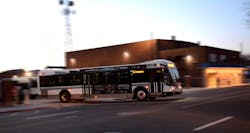Public transportation riders in the United States won’t remember 2017 fondly. Two of the country’s largest transportation systems faced an onslaught of challenges. The Washington Metropolitan Area Transit Authority's Metro system continued with its emergency repair work, and New York City’s Metropolitan Transportation Authority had several breakdowns that threatened rider safety.
These two public transit agencies, like many across the country, continue to operate with constrained budgets, growing ridership, and old equipment, leaving riders to ask whether things will ever improve.
The Rhode Island Public Transit Authority (RIPTA) thinks things can and will, and that the answer is hiding in plain sight.
This year, RIPTA and Uptake, a predictive data analytics software company in Chicago, connected to begin gathering and using RIPTA’s own data. RIPTA believes its data, combined with the right data science, will provide the insights necessary for its workers to take actions that increase bus reliability for riders, streamline its parts inventory and, ultimately, save taxpayer dollars.
“Maintenance software is one of the biggest things that I’ve been trying to bring to RIPTA for six years,” said Joe Monti, a RIPTA assistant maintenance superintendent.
RIPTA operates more than 200 buses and 100 vans across the Providence, Rhode Island, region. Approximately 45,000 people ride RIPTA each day throughout 36 of the 39 communities in Rhode Island. If just one of those buses breaks down, many problems follow: Late and frustrated riders, loss of confidence in public transportation and additional, often more expensive, repairs.
RIPTA, along with the rest of Rhode Island’s government, has been tasked to streamline operations and improve workflow as part of Rhode Island Gov. Gina M. Raimondo’s Lean Government Initiative.
At the federal level, the Federal Transit Administration (FTA) issued new rules in July 2016 that prioritize federal funding based on what is necessary to have assets operating in good condition. Part of the regulation requires public transit agencies to create an inventory of their assets, the current condition and what investment is necessary to keep or to return those assets to good condition.
Recently, Uptake spent time on-site with RIPTA, learning about its current operations and hearing from its mechanics, operations leadership, personnel managers and city officials.
Again and again, RIPTA officials said they want to stop problems before they happen, and workers want to be better at proactive maintenance and run a more efficient shop.
Anthony Mace, a maintenance foreman, said he would like to “be more proactive with repairs. And be able to monitor things like [diesel particulate filter] levels. And maybe get the buses in before breakdowns occur.”
Devices are now collecting data from buses. Robust work-order history and data from other areas of RIPTA are being gathered too. Not only will insights be generated from this data, those insights can be acted on to deliver positive outcomes. For RIPTA, the insights and lessons developed through the partnership will make 2018 better for the agency, its workers and its ridership.
For workers, they can make better and faster decisions that stop imminent breakdowns by fixing city buses before they ever leave the station, instead of when they’re on the street full of riders.
“I think a more preventive maintenance and inspection process certainly helps find more problems, and get rid of those problems ahead of time,” said Scott Fanny, a RIPTA mechanic.
When workers hear the words “big data” and “predictive analytics,” it can often lead to concerns about job security. But at RIPTA, the opposite happens.
Insights from predictive analytics are not competitors, but compliment the work maintenance workers do day-in and day-out. “You get a second set of eyes,” said Hank Williams, a mechanical foreman. “You aren’t going to need that tow truck every other day if you knew about [the potential problem] two days prior.”
For RIPTA leaders, real day-to-day outcomes like improved maintenance schedules, optimized part inventory forecasting and a more efficient fleet will help both time and taxpayer dollars.
All these improvements lead to riders being able to count on the bus to get them to their jobs on time each morning and to their families at home each night.
Keeping bus fleets well maintained and operating at their highest level will become even more critical for RIPTA and other public transit agencies across the United States during the next few decades. The U.S. Department of Transportation’s 2017 Beyond Traffic report estimates that the United States population will increase another 70 million people by 2040. Across the United States, 85 percent of people will live in cities.
The responsibility of moving more people safely and efficiently will fall on municipal and regional leaders, like RIPTA, already facing challenges. But predictive analytics can provide the insights these organizations need to put into the hands of their workers to meet those challenges. With this, 2018 should be a good year for RIPTA.
Trey Clark is the Director of Strategic Initiatives at Uptake, a $2B predictive analytics company based in Chicago. Clark leads Uptake’s Smart City and federal verticals.



